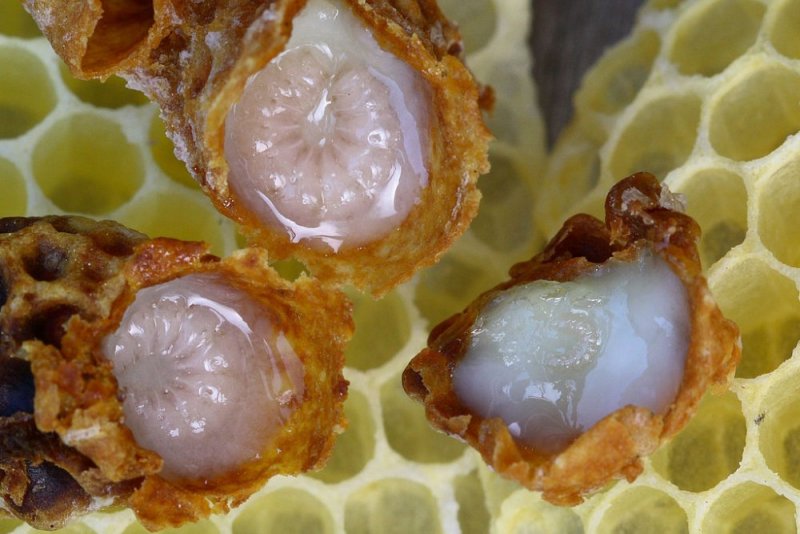Royal jelly is one of the basic honeybee products. Its consistency is reminiscent of homogeneous creamy to gelatin pap of white colour, but it can also have a touch of yellow or ochre. Its taste is sour to bitter-sour and has typical phenolic aroma. It is a source of proteins, vitamins, minerals, fats, nucleotides, sugars, and other components necessary for the life of honeybees. The balanced composition of royal jelly has evolved over 100 or 120 million years (i.e., since the documented occurrence of honeybees on our planet).
How does royal jelly originate?
Royal jelly is secreted by bees from their pharyngeal glands. Only so-called house bees, which are six to fourteen days old, can produce royal jelly. The basis for secretion of royal jelly is bee pollen. Pollen grains in the stomach of the house bee crack and from their content the bee then obtains important components for the formation of royal jelly. Bees need enough pollen, not only to produce royal jelly, but also as nutrition for the entire colony.
How do bees use royal jelly?
Bees use royal jelly as food for several kinds of bees. They feed with it adult mothers, future mothers (queens) and for the first three days also larvae of worker bees and drones. The composition of royal jelly varies depending on the kind of the bee to be hatched. „Royal jelly contains, in addition to general components, “slightly more” free amino acids, nucleotides, and vitamins for queen bees.“1
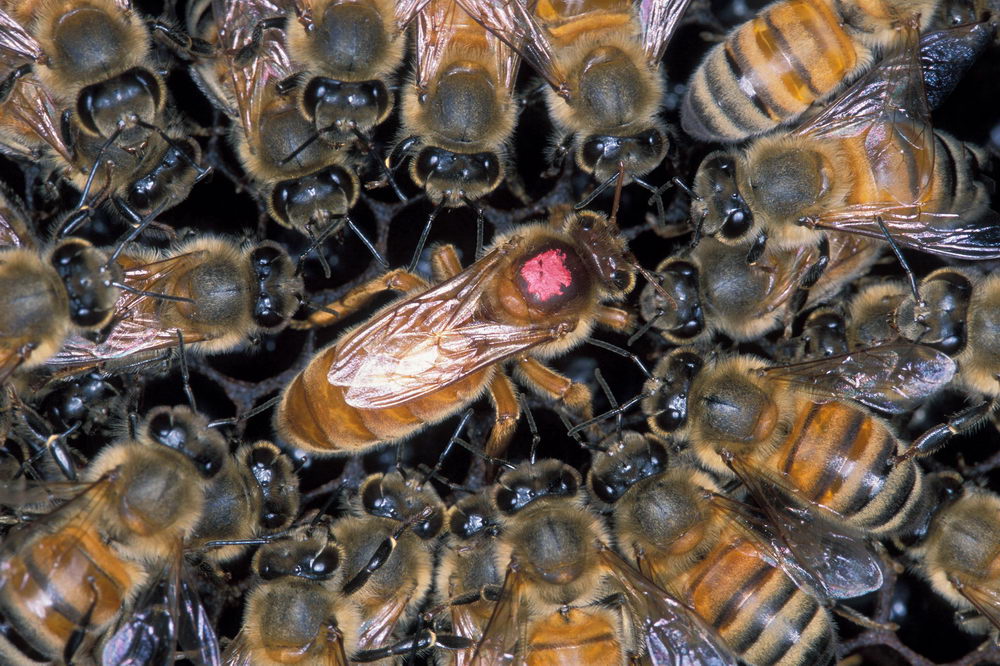
The consumption of royal jelly varies considerably in individual bees in the colony. Its biggest consumer is the queen bee, who moves around the honeycomb accompanied by several nurse bees - they take care of her, and royal jelly is constantly being offered to her. It is because of the consumption of royal jelly that the queen bee has exceptionally high brood vitality. In a single day, the queen can brood 1 honeycomb of a size approximately 16 decimetres. The weight of eggs that the queen bee lays during one day exceeds her own weight.
While ordinary worker bees live for two months and those long-lived for several months, queens live from 3 to 5 years. In exceptional cases, a queen bee can reach up to 7 years of age. „Many scientists explain this great difference in the life expectancy of the queen bee and a worker bee just with a different diet. It is just royal jelly that gives the queen a long life and fertility.“2
Composition of royal jelly
„Royal jelly is one of the most mysterious natural products and its composition is not yet entirely enlightened. It contains a large number of components that create a nutritious mixture with unique properties.“3
„Royal jelly contains: mostly water (50 - 70 %), dry matter consists mainly of sugars, proteins (10 - 20 %), lipids (3 - 10 %), but also many other elements, which albeit making up a smaller proportion by content, are extremely effective and important."4 We will look at them in more detail in the next paragraph.
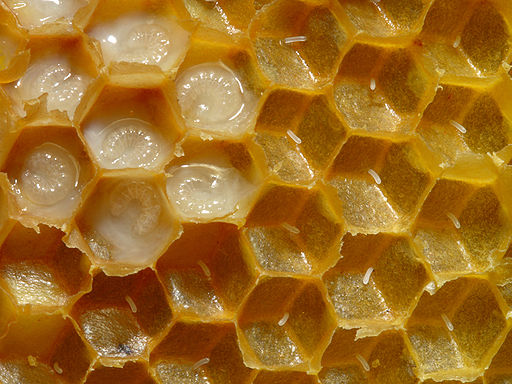
"Of sugars, glucose and fructose are mainly present, in a similar proportion as in honey. The sucrose content varies from sample to sample. Other sugars are present in small quantities: maltose, trehalose, melibiose, ribose and erlose.
Of fatty substances, for example, 10-hydroxy-2-decenoic acid is important, which inhibits growth of bacteria (and, therefore, royal jelly is microbially very stable despite the high water content) and its saturated equivalent, 10-hydroxydecenoic acid. Namely fatty acids seem to be responsible for most of the recognized biological properties.
Native royal jelly contains about 1% of mineral substances, most of which potassium, followed by calcium, sodium, zinc, iron, copper, manganese and more. The content of vitamins in royal jelly is relatively very low. The previously discussed and overestimated content of sex hormones was also determined at very low levels.
However, a significant effect of other, yet little known or unknown substances cannot be ruled out. Of heterocyclic compounds there are pterin and neopterin, a number of nucleotides and nucleobases, high content of macroergic phosphates (AMP, ADP, ATP), acetylcholine and other substances. “5
The composition of royal jelly corresponds to what is best available in the area. It is in the pollen of flowers where the most valuable substances from the plant itself are found, but also the best from the local soil. The difference between the proportions of individual components of royal jelly is therefore mainly made by the area where the bees collect pollen and what plants are available to them. This is one of the reasons why, for example, the ratio of protein percentages diverges by a whole double - once it can be only 10 %, while in a more fertile region 20 %..
„Royal jelly contains a number of vitamins that have a therapeutic effect:
-
Vitamin B1, that regulates sugar management and protects the central nervous system.
-
Vitamin B2, whose deficiency causes growth disorders, damage to skin, mucous membranes, and causes states of fatigue.
-
Vitamin B3 that helps maintain a healthy central nervous system, helps the body use carbohydrates, lipids, and proteins, and improves the condition in chronic fatigue syndrome, migraines, digestive problems, and some allergies.
-
Vitamin B6, whose deficiency causes hair loss, eczema, and nerve damage.
-
Vitamin B7 that acts against inflammation of the skin and eyelids.
-
Vitamin C that acts preventively against bleeding gums.
-
Vitamin B9 that is essential for all cell division and growth processes.
-
Vitamin E that stimulates sexual activity, protects against abortion, and acts against sterility.
-
Vitamin B12 that maintains healthy nerve cells and red blood cells and the proper functioning of the central nervous system.
-
Vitamín D that promotes proper calcium absorption and maintains proper calcium and phosphorus levels in blood.“6
It is very interesting that „no microorganisms were detected in royal jelly - this product therefore has the ability to sterilize itself“.7
Acquisition of royal jelly
Royal jelly is found in queen cells (honeycomb) with 3- to 4-day-old larvae. From there, it is collected with a small wooden scoop or extractor and placed into a cooled dark glass container. Some beekeepers mix it directly into honey.
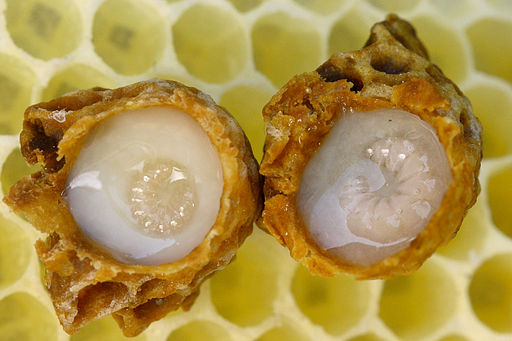
Photo: Wikimedia Commons author: Waugsberg, CC BY-SA 4.0;
„Beekeepers in the apiary enjoy consuming royal jelly obtained in this way directly in their native form when terminating honeycombs. According to Dr. Stangacio, it is effective to consume royal jelly with beeswax and larva, because in this case the larva is otherwise unusable. It is a high-quality biological material with extraordinary effects on human body.“8
History of the use of royal jelly
Royal jelly was already known and used by ancient Egyptians and Romans. They used it for curing, but also for cosmetic purposes. Unfortunately, knowledge about the properties of royal jelly and other bee products was not deepened in ancient nations and passed on following generations. Therefore, royal jelly became known to serious medicine only in more modern times and was subjected to scientific research even later.
In 1680, a Dutch Swammerdam described it as the bee´s salivary honey. A French naturalist Reaumur proved that it is a substance secreted by the pharyngeal glands of bees. In his 18th century work, he stated that royal jelly is a "super nutrition” and presented it as concentrated food. His knowledge was extended by his Swiss colleague Huber, who proved that thanks to royal jelly any larva can develop into a sexually mature female, i.e., the queen.
The period of the greatest glory of royal jelly dates back to the 1960s. In 1953, B. De Belvefer obtained a patent to produce a preparation from royal jelly, which made him famous all over the world. In the second half of the last century, royal jelly was extremely popular with the public, but also with physicians.
Storage of royal jelly
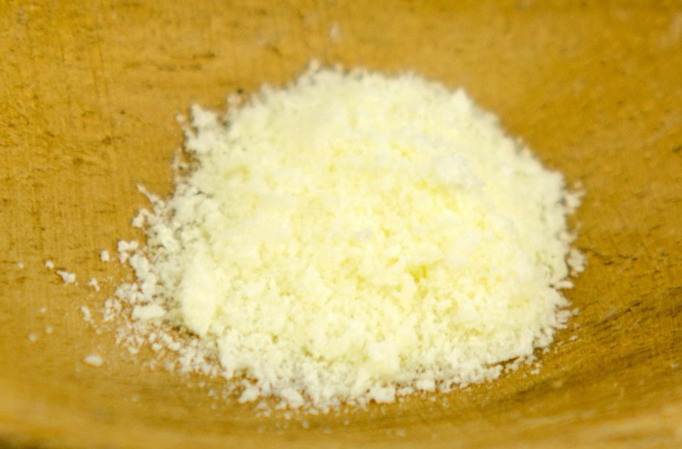
Lyophilized royal jelly
Royal jelly is a relatively sensitive substance that does not tolerate contact with metals. Therefore, do not forget that it is not good to scoop it up with a metal spoon! It is also damaged by sunlight, heat, oxygen, and any impurities. It must therefore be preserved immediately after acquisition.
It is stored in pure form, freeze-dried, or mixed with honey. Fresh royal jelly is stored in a cool and dark environment of a refrigerator at a temperature of 3 to 5 degrees; the temperature should not fall below the freezing point; under these conditions it will last a maximum of half a year.
Preserved in honey or in freeze-dried form lasts 1 year. The shelf life of royal jelly can be extended by freezing at ideal temperatures of -15 to -20 degrees; then lasts 2 years in the freezer. Do not refreeze once thawed. However, we always recommend consuming pure royal jelly and royal jelly in honey as soon as possible.
Therapeutic use of royal jelly
„Royal jelly is used to treat a wide range of diseases and health conditions. It is used for the treatment:
-
of bronchial asthma,
-
insomnia,
-
acne,
-
anaemia,
-
asthenia (general weakness),
-
arteriosclerosis,
-
against depression,
-
atherosclerosis,
-
lower limb arthritis,
-
encephalitis,
-
liver diseases,
-
duodenal ulcers,
-
in menopausal problems,
-
in loss of appetite,
-
in neurasthenia,
-
some types of paralysis,
-
in case of delayed development of children,
-
multiple sclerosis,
-
Parkinson´s disease,
-
stenocardia,
-
in case of weakening of sight and hearing without significant causes,
-
in inflammation of the colon,
-
against hair loss,
-
after surgeries,
-
after childbirth with severe blood loss,
-
in convalescence after serious illnesses, injuries, and surgeries,
-
to stimulate the endocrine glands - thyroid gland, adrenal glands, gonads,
-
to adjust blood pressure (increases low pressure and decreases high pressure),
-
to improve the overall physical and mental condition,
-
to suppress the adverse effects of broad-spectrum antibiotics,
-
in the treatment of vegetative dystonia,
-
in the treatment of depressive conditions,
-
peptic ulcers of the stomach and duodenum,
-
to reduce mental and physical overloading,
-
in the treatment of difficult to heal wounds and burns,
-
when the organism is exhausted,
-
royal jelly smoothens out and rejuvenates skin and effectively acts on a wide range of skin conditions.“9
The exact dosage of royal jelly for individual diseases is given below in the section Use of royal jelly. However, this is an overview of the most common health problems only.
„Royal jelly does not only have a specific effect on some organs, but it interferes with the overall metabolism and affects the whole body. It is known that it supports the entire immune system and helps to treat a wide variety of diseases.“ 10
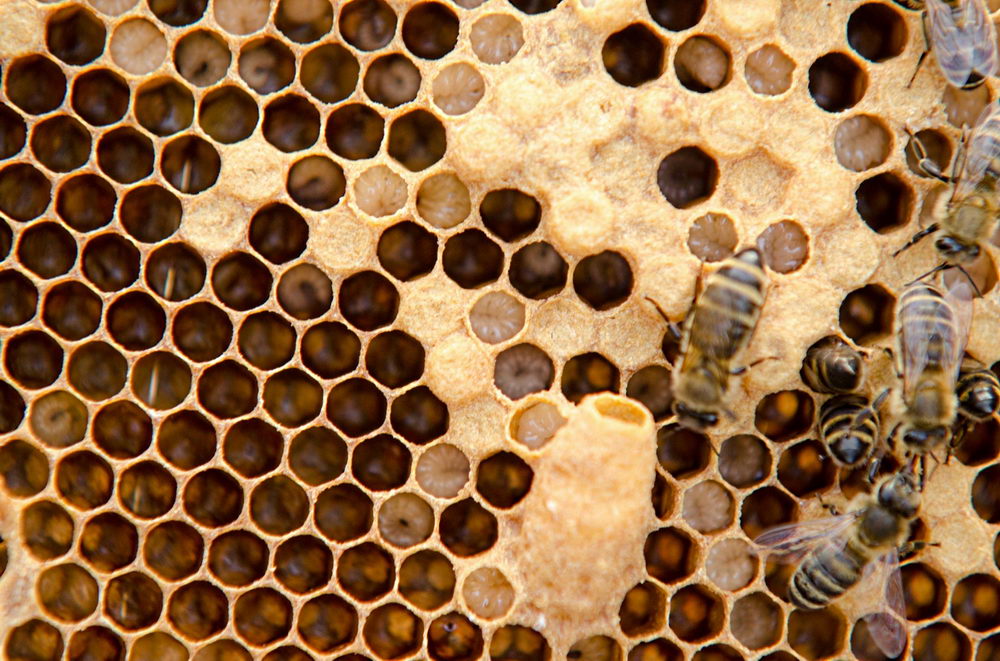
„If we repeat the disease conditions on which royal jelly has a beneficial effect, we can say that we also have other effective drugs for many especially inflammatory and infectious diseases and royal jelly has become an enrichment of our healing arsenal. What is more interesting, is a group of diseases that can be attributed to civilization.
This includes all conditions caused by exhaustion, disgruntlement, and disruption of the nervous and psychic system, which eventually manifest themselves in disorders in the mental sphere, or physical consequences, and most often both. Those include menacing infarctions of the heart muscle, premature physical and mental ageing, and to some extent perhaps even malignant tumours. It is a global problem and the more developed the state, the worse the situation. As a result of haste, lack of rest, and psychological pressure, mental uneasiness arises, just as consequences of civilisation diseases, none of which is easy.“11
Royal jelly as a food supplement
„Royal jelly is suitable for all those who do not suffer from direct health problems but want to stay in shape and fit thanks to nature. It has the following utility and therapeutic properties:
-
highly nutritious product with a high content of proteins and vitamins,
-
has a beneficial effect on the brain,
-
causes an increased number of erythrocytes, while increasing the amount of haemoglobin as well as iron content in blood,
-
has a bacteriostatic and bactericidal effect,
-
has a tonic, anti-radiation, and immune effect,
-
stimulates metabolism, increases life tone of the body,
-
normalizes blood pressure,
-
improves elasticity of blood vessels,
-
improves function of internal organs,
-
does not only have a specific effect on some organs, but it interferes with the overall metabolism and affects the whole body,
-
increases defence forces of the organism and thus the overall activity of the body,
-
it is a valuable support remedy for a wide range of diseases.“12
„People who use royal jelly on a regular basis confirm that they feel very well, are more physically efficient and fatigue-resistant, have better learning ability and memory capacity, better mental condition, self-confidence, and good mood. Thus, royal jelly probably contributes to the overall stimulation, higher resistance, and the proper functioning of human body.“13
Use of royal jelly
Royal jelly is usually taken orally, most often in the form of tablets or freeze-dried powder. It is also common in honey and its combinations. Another abundant use is in the form of ointments, creams, and liquids.
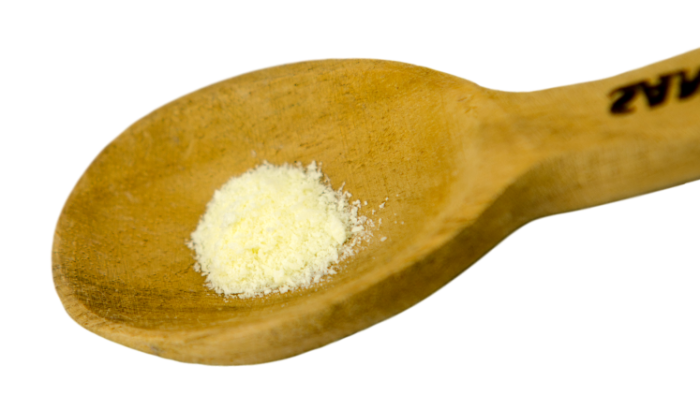
The most appropriate is the use of royal jelly in natural raw form, not mixed with anything and non-preserved.
When using natural royal jelly, observe important principles: „Royal jelly should not be swallowed, it must be allowed to dissolve completely in the mouth. As soon as it gets into the stomach, it loses its properties due to the action of acid gastric juices. Therefore, royal jelly is also not to be swallowed with water or other beverages or to be taken together with food."15 „The recommended dose is 0.5 g of fresh (or 200 mg freeze-dried) jelly once a day, ideally in the morning on an empty stomach, approximately 20 minutes before meals. In this case, royal jelly is given under the tongue, where you hold it for about 5 minutes. The recommended period of use is then 2 to 4 weeks.“16
In case of royal jelly in honey or in combination with pollen or propolis, use the mixture according to the dosage above, again in the morning on an empty stomach, approximately 20 minutes before breakfast. You can repeat the cure with royal jelly after 2 to 3 months.
Administration of royal jelly in the most common problems and diseases:
„Asthma: 1 teaspoon of honey mixed with royal jelly a day.
Gastric ulcers: 1 teaspoon of honey mixed with royal jelly, 30 minutes before a meal in the morning. In addition, 25 to 30 drops of propolis tincture 3 times a day.
Insomnia: 1 teaspoon of royal jelly with honey for the night.
Menopause, melancholy, depression: 1 teaspoon of royal jelly with honey 30 minutes before a meal.
Inflammation of the oral cavity: 1 teaspoon of a mixture of royal jelly and propolis has very good results. Leave it in your mouth until it dissolves.
Eczemas: Use 1 teaspoon of a mixture of royal jelly, honey, and propolis tincture internally or externally. Use the mixture in a ratio of 94% honey, 4% royal jelly, and 2% propolis tincture. Only prepare a small amount.“18
Other findings on the effects of royal jelly
„Royal jelly has a wide range of biological properties. It stops the growth of various types of microorganisms (intestinal bacteria, golden staphylococci, tuberculosis bacteria, salmonella, anthrax agents, etc.). Data exist on the antiviral activity of royal jelly and, in part, on its ability to destroy influenza virus.“ 19
Dipl. Eng. Štefan Demeter, Ph.D. presents in his book Apitherapy: Treatment with Bee Products a number of findings of his American colleagues:
-
„Royal jelly helps the brain, so it remains “young” – does not age, contains acetylcholine, which functionally serves the cerebral nerve network to transmit information,
-
supports a decrease in levels of acetylcholine that causes memory loss and lack of concentration at a more advanced age,
-
is also a good source of vitamin B5, which is highly regarded for its anti-degenerative and anti-ageing effects,
-
royal jelly also contains amino acids and gamma globulin that strengthen our immune system and help overcome viral infections,
-
it also contains sterols, phosphorus and acetylcholine compounds needed to transfer information between nerve cells.
These findings could help reduce the number of antibiotic-related adverse effects and reduce the volume of antibiotics prescribed by physicians.“20
The large extent and potential of the use of royal jelly is also in cosmetic products. „The application of royal jelly to the skin in many studies has shown its anti-inflammatory effect. Royal jelly is part of a series of dermatological preparations used to refresh, regenerate, and rejuvenate skin. It is usually also a compound of ointments for the treatment of burns and other wounds.“21
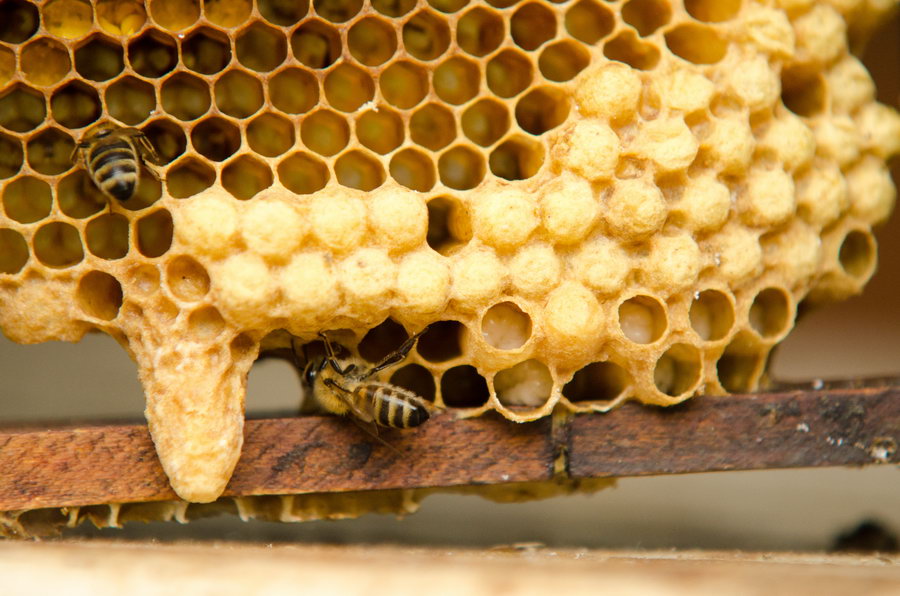
In his book Bee Products in Nutrition, Medicine, Pharmacy, and Cosmetics, J. Stoklasa M.D. described results of several studies which found that „preparations containing royal jelly remove wrinkles, rejuvenate skin, and support skin regeneration. Other authors praise the effect of topically applied royal jelly in cosmetology. Here, its biologically stimulating effect is manifested in better blood supply, tension, and in the overall appearance of the skin. In our country, Fišera described the beneficial effects of royal jelly in the treatment of skin changes caused by its physiological ageing. He found that after 5 weeks, the superficial incipient wrinkles on the forehead of the patients being treated smoothened out and that the flabellate wrinkles in the eye area also receded in about one third of the patients. Other recorded outcomes of royal jelly were significant acceleration of the healing of smaller scars or sunburns.“22
Exceptional bee product
„So, what are the effects of royal jelly on human body? Is it really a miracle cure? Experience with its use and treatment, which has accumulated for decades and centuries, has proven that it has a very positive effect on human body, both sick and healthy. Royal jelly is an exceptional food. The above descriptions concerning diseases and conditions, we want to improve, but also many others, show that it is a truly extraordinary product. I can warmly recommend alternative treatment with royal jelly to the general public. To beekeepers, then, its study, production, and utilisation.“23
Introductory photo: Wikimedia Commons, author Waugsberg, CC BY-SA 3.0;
1 Czech publication: Ing. Štefan Demeter, CSc.: Apiterapie: Léčení včelími produkty; Vydala Mgr. Andrea Lenochová, Olomouc, 2015, str. 107, ISBN 978-80-87274-27-9 Back
2 Czech publication: kolektiv autorů: Mateří kašička a propolis; Bratislava, Eugenika, 2017, str. 11, ISBN 978-80-8100-519-0 Back
3 Czech publication: kolektiv autorů: Mateří kašička a propolis; Bratislava, Eugenika, 2017, str. 10, ISBN 978-80-8100-519-0 Back
4 Czech publication: Ing. Štefan Demeter, CSc.: Apiterapie: Léčení včelími produkty; Vydala Mgr. Andrea Lenochová, Olomouc, 2015, str. 107, ISBN 978-80-87274-27-9 Back
5 Czech publication: Titěra, Dalibor: Včelí produkty mýtů zbavené; Praha, Nakladatelství Brázda, 2006, str. 139-140, ISBN 80-209-0347-X Back
6 Czech publication: Ing. Štefan Demeter, CSc.: Apiterapie: Léčení včelími produkty; Vydala Mgr. Andrea Lenochová, Olomouc, 2015, str. 108–109, ISBN 978-80-87274-27-9 Back
7 Czech publication: kolektiv autorů: Mateří kašička a propolis; Bratislava, Eugenika, 2017, str. 13, ISBN 978-80-8100-519-0 Back
8 Czech publication: Ing. Štefan Demeter, CSc.: Apiterapie: Léčení včelími produkty; Vydala Mgr. Andrea Lenochová, Olomouc, 2015, str. 114, ISBN 978-80-87274-27-9 Back
9 Czech publication: Ing. Štefan Demeter, CSc.: Apiterapie: Léčení včelími produkty; Vydala Mgr. Andrea Lenochová, Olomouc, 2015, str. 110–111, ISBN 978-80-87274-27-9 Back
10 Czech publication: Ing. Štefan Demeter, CSc.: Apiterapie: Léčení včelími produkty; Vydala Mgr. Andrea Lenochová, Olomouc, 2015, str. 112, ISBN 978-80-87274-27-9 Back
11 Czech publication: MUDr. Jan Šmíd: Včelí produkty ve výživě a lékařství; Liberec, 1968, str. 56–57 Back
12 Czech publication: Ing. Štefan Demeter, CSc.: Apiterapie: Léčení včelími produkty; Vydala Mgr. Andrea Lenochová, Olomouc, 2015, str. 115, ISBN 978-80-87274-27-9 Back
13 Czech publication: Titěra, Dalibor: Včelí produkty mýtů zbavené; Praha, Nakladatelství Brázda, 2006, str. 141, ISBN 80-209-0347-X Back
14 Czech publication: Ing. Štefan Demeter, CSc.: Apiterapie: Léčení včelími produkty; Vydala Mgr. Andrea Lenochová, Olomouc, 2015, str. 114, ISBN 978-80-87274-27-9 Back
15 Czech publication: kolektiv autorů: Mateří kašička a propolis; Bratislava, Eugenika, 2017, str. 34, ISBN 978-80-8100-519-0 Back
16 Czech publication: Ing. Štefan Demeter, CSc.: Apiterapie: Léčení včelími produkty; Vydala Mgr. Andrea Lenochová, Olomouc, 2015, str. 113, ISBN 978-80-87274-27-9 Back
17 Czech publication: Ing. Štefan Demeter, CSc.: Apiterapie: Léčení včelími produkty; Vydala Mgr. Andrea Lenochová, Olomouc, 2015, str. 112, ISBN 978-80-87274-27-9 Back
18 Czech publication: Ing. Štefan Demeter, CSc.: Apiterapie: Léčení včelími produkty; Vydala Mgr. Andrea Lenochová, Olomouc, 2015, str. 120–121, ISBN 978-80-87274-27-9 Back
19 Czech publication: kolektiv autorů: Mateří kašička a propolis; Bratislava, Eugenika, 2017, str. 18, ISBN 978-80-8100-519-0 Back
20 Czech publication: Ing. Štefan Demeter, CSc.: Apiterapie: Léčení včelími produkty; Vydala Mgr. Andrea Lenochová, Olomouc, 2015, str. 115, ISBN 978-80-87274-27-9 Back
21 Czech publication: Titěra, Dalibor: Včelí produkty mýtů zbavené; Praha, Nakladatelství Brázda, 2006, str. 142 - 143, ISBN 80-209-0347-X Back
22 Czech publication: MUDr. J. Stoklasa: Včelí produkty ve výživě, lékařství, farmacii a kosmetice; Státní zemědělské nakladatelství, Praha, 1975, str. 153 - 154, ISBN neuvedeno Back
23 Czech publication: Ing. Štefan Demeter, CSc.: Apiterapie: Léčení včelími produkty; Vydala Mgr. Andrea Lenochová, Olomouc, 2015, str. 122, ISBN 978-80-87274-27-9 Back

